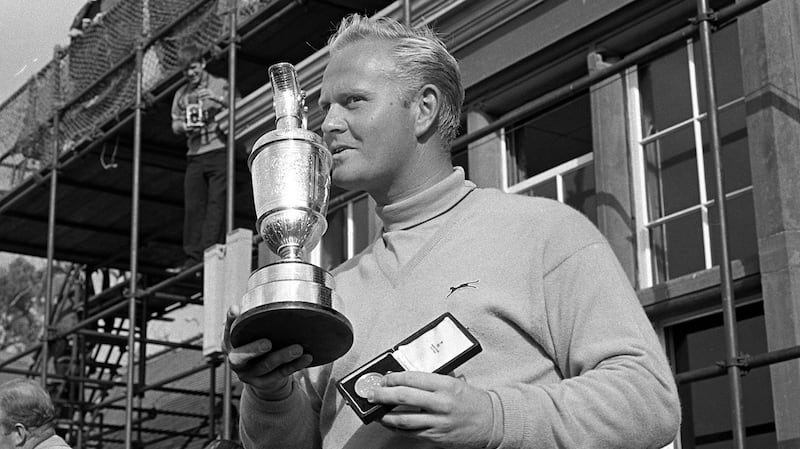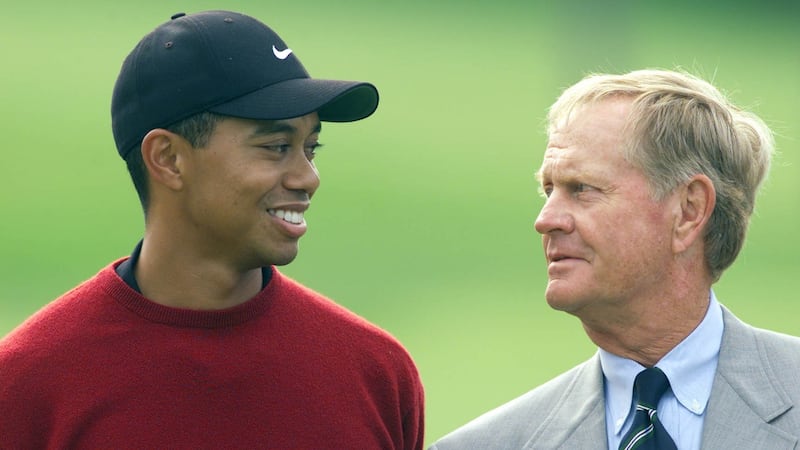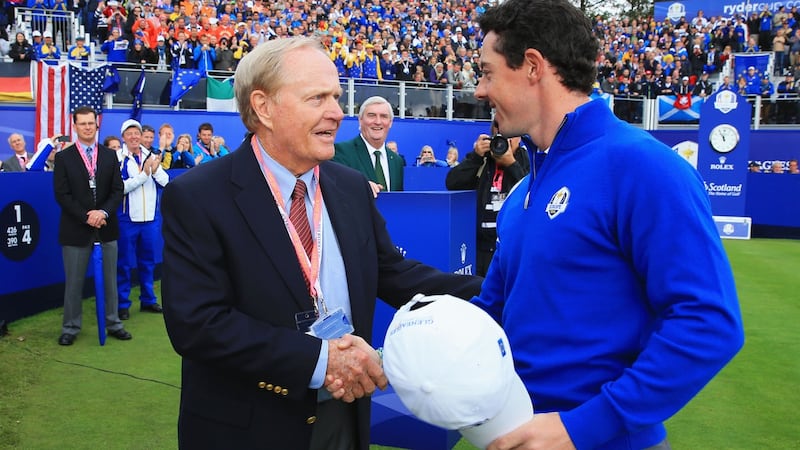“What would you like to know?” enquires a brisk voice on the phone – and it’s unmistakably his voice: plaintive and youthful, slightly gravelly and redolent of an era when professional golf was more patrician and relaxed; a voice steadfastly fixed in the decorum and ingrained modesty associated with the decades of American life in which he was raised.
Fourteen years after his valedictory British Open appearance at St Andrews and the poignant farewell on Swilken Bridge where Tom Watson, not he, succumbed to tears of emotion; 33 years after the 18th and last of his Major titles and a stunning 22 years since Tiger Woods began his own assault on that record, Jack Nicklaus stands as golf's untouchable and slightly reticent embodiment of greatness.
He won the British Open on three occasions: 1966, 1970 and in 1978, but put himself in the frame to win for every tournament between 1963 and 1980 except for Birkdale in 1965.
I stood on 16 and said to myself that if I finish on 3-4-4 I am gonna win the tournament. And I finished 3-4-4 and won
“That was where I finished 13th,” he says from his Florida home, where he was preparing for Independence Day celebrations followed by a fortnight touring Europe, where Killeen Castle in Co Meath is among the courses he has designed. Other commitments will prevent him from visiting Royal Portrush but he has ambitions to play the course “someday”.
“Sixty-four was my first run at St Andrews and you can get the bad side of the weather there. I shot 68 in the last two rounds to finish second. Then ‘66 was at Muirfield and, of course, that golf course was set up as the antithesis of how I felt it should be set up. The rough was a foot and a half deep right off the fairway.
“It was not set up for Jack Nicklaus. But anyway . . . I used the driver just 17 times and the 17th time almost cost me the tournament. And I stood on 16 and said to myself that if I finish on 3-4-4 I am gonna win the tournament. And I finished 3-4-4 and won.”
You can watch any number of archived television interviews with Nicklaus and this is how he will speak: understated, matter of fact and logically making what to the world seemed to be a form of uncanny magic to be little more than common sense approach.

Here he is on NBC when asked what it is that separates the merely technically excellent golfers from those who soar into the record books. “I don’t know. I just do the best I can. There was only one person I could control. That was me.” On one level those sound like stock answers but on another they reflect the kind of temperament and mindset that every sports organisation and individual in the world now pays psychologists hefty fees in order to try and achieve.
Temperament
Nicklaus's fortune was to possess that temperament inherently. When he won his first British Open at Muirfield, among those following inside the ropes was the golf writer Herbert Warren Wind. In what might well be the definitive written piece on Nicklaus published in the New Yorker in 1983, Wind writes: "The most sensational single hole I have ever watched Nicklaus play was the 17th hole at that 1966 Open," before going on to describe the three and five iron shots he made to approach the green of the 528 yard Par 5 for the birdie opportunity which sealed his win.
Asked now, out of the blue some 43 years and thousands of holes later if he can recollect that moment, Nicklaus talks you through it as if it’s still July 9th in 1966 and he has just come into the clubhouse, flushed and victorious.
“Sure. I hit my three almost too far left and had about 235 downwind and hit a five iron, which was right. I don’t remember where it went . . . it must have been on the green and I two-putted from there. I played the last with a one and three iron and hit that to about 20-foot and two-putted that to win the tournament. The five and three is an example of how the game turns around.
“When I went back in ‘72, the wind was the opposite and I played a driver and hit the rough. And I had trouble getting it across the cross bunkers and had to play an iron into the green and made five. I stood on the green in ‘72 and said the same thing. If I finish 3-4-4 I am going to win the tournament. And I finished 4-5-4 and lost by one.”
My father taught me that when somebody beats you fair and square, then you need to be happy for them too
He had to wait until 1970 to land his next British Open, beating Doug Sanders after a play-off (the prize fund in 1970 was £40,000) and by the time he lifted the Claret Jug for the third and final time in 1978, Nicklaus had entered a different realm in the public consciousness.

It's hard for anyone who can remember Nicklaus's last ever major win, that improbable burst of "bottled lightning" at the 1986 Masters, to imagine him as anything other than a revered figure in the game. But when he first burst onto the scene to compete with Arnold Palmer in the early 1960s, the reaction across America's golf public was complex.
“In the eyes of Palmer’s fans, Nicklaus, the corpulent, expressionless kid who had supplanted their hero, was an unwelcome observer,” wrote Wind in that same piece. “Nicklaus took all this in, stoically, and got through it. For several years, even when he stood alone at the top, he had a limited appeal for the average golf fan. Most of the regulars in his galleries were people who had been close to golf all their lives and could appreciate the beauty of his shot-making. Then, slowly, starting in about 1970, the situation began to change. Nicklaus not only earned an ever-increasing esteem at home and though the world but also emerged as one of the most popular figures in modern sports.”
That estimation was gold stamped not so much by Nicklaus’s third British Open win but by his performance in the preceding year, at Turnberry in 1977. Some quality about the Nicklaus and Tom Watson stroke-by-stroke, hole-by-hole showdown that year became emblematic of that era in British life.
Duel in the Sun
It probably helped that the Ayrshire course was unusually sun-bleached and the newspaper headline “The Duel in the Sun” was so good and succinct that it gave that final round a cinematic quality. The scene on the 18th was unforgettable: a crowd of maybe 23,000 packed around and dead silence in the heat as Nicklaus studied a 35 foot putt that he needed just to stay alive before coolly delivering the perfect closing shot. It turned out to be in vain: Watson made his two footer to win the tournament by one. But Nicklaus’s nerveless closing shot and his instantly warm reaction to Watson’s joy anointed the moment.
“I had to make it if I had any chance,” he reasons now. “Tom was not going to miss . . . he had a couple of feet at the most. So the only chance I had was to make it. And obviously that makes you feel good but Tom made his putt and you know, he just played better than I did. I missed a five footer on 17. The ball did not go the way I thought it would go. And that was a turning point.
“There was not much I could do about it. I prepared well. I played well. He just played better. I don’t remember what I said to him at the time. Tom was a good friend and we got along well so I probably had some wise remark I made to him. My father taught me that when somebody beats you fair and square, then you need to be happy for them too. So I was happy for Tom too even though I was disappointed for myself.”

Maybe the key to what made Nicklaus what he became was time and place. Born in 1940 in Columbus just as the city was experiencing a population and employment boom: a Midwestern baby boomer of Germanic stock. His father Charlie was a pharmacist in his professional life but in essence, he was a phenomenal sportsman, representing Ohio State University at football, basketball and baseball. It was only when an ankle break failed to clear after three operations and a doctor warned him to maintain only moderate exercise or risk ending up in a wheelchair that golf became part of the family life.
“That is when he took me along. He introduced me to all the sports and by the process of elimination in each sport, even though I was probably pretty decent I wasn’t good enough to take it to the next level. And golf was something I could work at, spend time on and didn’t need someone there to help me. I didn’t need someone there to help me. Through my own efforts I could be as good as I wanted to be. And that excited me. It interested me. And that’s why I think I ended up with golf.”
Charlie Nicklaus died at just 56, in 1970: he lived long enough to see his son become one of the world's best players but was gone long before he tore up through the ranks of all-time major winners. In six decades of public life, Nicklaus has moved from leading golfer to icon, always accessible and charming with the public but always at a reserve, too, and adhering to the values instilled by his father when he was learning the game in the 1950s.
“Sportsmanship was one. Committing to doing something and doing it was another. Whatever it was, do it to the best of your ability or otherwise you would never be happy or satisfied with yourself. I think that is about all you can ask of yourself. My sister, I always say, got the short end of the stick because my dad was wrapped up in what I did. We lost him at age 56 and it was much too young. He saw about half of what I did. And I played as much for him as I did for myself.”
Trump is very well supported and I think he has done a very good job
Maybe good fortune played a role in that the polio Nicklaus contracted at age 13 did not destroy his athleticism and maybe it was fated that Jack Grout, a profound formative influence, was the club professional at his local club in Columbus. But it was Nicklaus's stoicism and temperament and powerful driving game that propelled him to Major victories over three decades. In all of that time, he remains true to those mid-century values: a venerated American sportsman, modest, essentially private but also entirely unafraid of pronouncing himself as conservative and in support of the Trump administration irrespective of what people think.
Trump
“Our country right now is more divided than it has ever been,” he says gravely. “I think it is all about power and who controls what. I think the media has gotten into it to such a degree that it is in front of people all the time all over the world. Ninety per cent of the media is liberal here. And you have a tainted view internationally of what America is all about.
“Take middle America . . . excluding New York and California, which are very liberal. The rest of the country feels that jobs are up, income is up, jobs are doing well, Trump is very well supported and I think he has done a very good job. And I just don’t understand some of the ideas that are going on today in our media and with our politicians. But it’s a hard situation and I wish people would come together. You know, we are all Americans.”
Nicklaus has acted as a sort of metaphor for American excellence, shining and dependable on the golf course through the political and social tumult and chaos of the past five decades. He was a beacon of dependability: the Golden Bear, in yellow shirt, bathed in sunshine. At 76, he remains a hugely pertinent and relevant name in contemporary golf. Even though he is no longer playing the tour, the current field must always play against what he achieved. His US Open amateur record of 282, set at Cherry Hills in 1960, was broken only months ago by Viktor Hovland, who finished two strokes less at Pebble Beach.
“My feeling on that one was: scores are going down. The record I shot – I was an amateur finishing second. The record he broke, I don’t know where he finished. Twelfth, I think. That is a nice score at Pebble Beach. But I don’t think that it’s apples and apples. I was happy for Viktor to shoot a nice score and records are there to be broken. That is fine. But I think where you finish in the tournament is more important than the score. He is going to have a nice career . . . he is a nice player and is going to do well. So I would congratulate him on the score but it’s where you finish in the tournament.”
The big record, of course, is the ongoing, through-the-decades all-time Majors race between Woods and Nicklaus. It had seemed effectively over, with Woods stuck on 14 from 2008 through to his rebirth at the Masters in Augusta last April. All of the old comparisons and what-ifs and who-is-better conversations and questions are alive again. Nicklaus handles them easily even if he concedes that those debates are futile.
"They are very difficult. Tiger would be a champion when I played. Tiger would have been a champion when Bobby Jones played. I think I would have been a champion when Bobby Jones played and a champion today. Who would be the best? Who knows? Tiger is a whole different player. He has done very, very well and I certainly wouldn't put him down in any way shape of form. I guess I was a good player in my era too. So to compare them? I don't see how you can."

During Rory McIlroy’s burst of four majors in three seasons, there was speculation that he had both the time and talent to join the chase for Nicklaus’s record. Now, the hope is that his familiarity with Portrush will help McIlroy to land another after a five- year gap. Nicklaus has made no secret of his fondness for the McIlroy and suggests the people reserve judgement on the issue of his consistency.
“Well. I think that consistency is where you give yourself so many exposures of being there. You may not win ‘em all but you are going to win some of them. That is basically what I did. I don’t even know what my record is off the top of my head. But I was usually there somewhere. And I think Rory has had a tendency to be right there – or not there. I believe he has just turned 30. And I think he has his best golf in front of him. I watch him practice and I talk to Rory a lot. He has so much talent and so much in front of him that to try and compare today, I think, is very difficult. Ten years from now we could have the same conversation.”
In 10 years time, of course, there’s faint chance that Jack Nicklaus may have been surpassed on the all-time majors honour roll. If that happens, you can be sure he will take it in his stride. After all, he did his best with what he had. That’s all he was ever asked to do.












